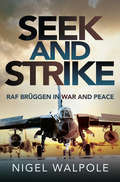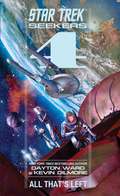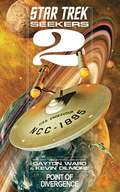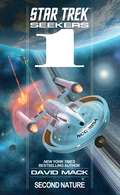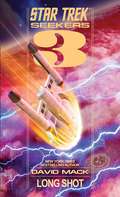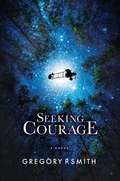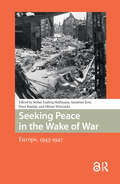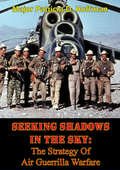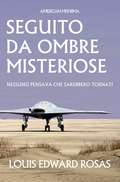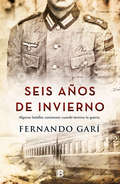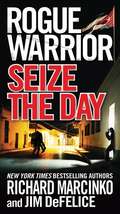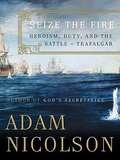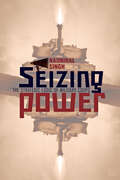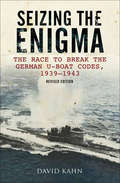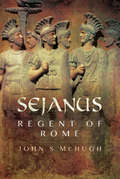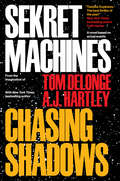- Table View
- List View
Seek and Strike: RAF Brüggen in War and Peace
by Nigel Walpole&“A slice of the RAF and NATO in Germany through the Cold War . . . cover[s] the range of jets used by the RAF, from the Vampire to the Tornado.&” —Firetrench This is an anecdotal history of the largest RAF station in Germany. Optimized for a new breed of aircraft, and to NATO requirements, this huge airfield was cut out of the Elmpt Forest, on the German border with Holland, and completed in one year to become operational in 1953. First occupied by a fighter wing equipped with Vampires, Sabres and Hunters, its &“Seek and Strike&” motif took on real meaning when the station re-equipped with strike, attack and reconnaissance Canberras, followed by strike/attack Phantoms, Jaguars and finally Tornados. RAF Brüggen was at the forefront of the Cold War, during which innovation and determination brought it many accolades. It further distinguished itself in the Gulf War and continued to play its part in subsequent monitoring operations in that theater; it was also the only Tornado Wing to operate directly from its home base during the Kosovo campaign. This is the story of a station at war, of the men and women at the sharp end and in support. At work and play, it was they who made Brüggen what it was, excelling in all things and justifying a claim to have been RAF Germany&’s &“jewel in the crown.&” With its closure in 2001, the RAF relinquished its last main operating base outside the UK. Brüggen was indeed &“last and best.&” &“A story of the people who served at Brüggen, their families and the local population, and how their lives were entwined with the station.&” —Flight Line Book Review
Seekers: All That's Left (Star Trek: Vanguard )
by Dayton Ward Kevin DilmoreAn all-new novel in the acclaimed Star Trek: Vanguard spin-off series! Initially charted by Starfleet probes dispatched to survey the Taurus Reach, the planet Cantrel V now plays host to a budding Federation colony as well as a combined civilian/Starfleet exploration team. Ancient ruins of an unknown civilization scattered around the planet have raised the curiosity of archaeologists, anthropologists, historians, and other interested members of the Federation scientific community. Together, they are attempting to shed light on the beings that once called this world home. After a large, unidentified vessel arrives in orbit and launches a seemingly unprovoked orbital bombardment, the U. S. S. Endeavour responds to the colony’s distress call. As they attempt to render assistance and investigate the mysterious ship, Captain Atish Khatami and her crew begin to unlock the astonishing secrets the planet has harbored for centuries. Does the survival of a newly discovered yet endangered alien race pose a threat not only to Cantrel V, but to other inhabited worlds throughout the Taurus Reach and beyond? ™, ®, & © 2015 CBS Studios, Inc. STAR TREK and related marks and logos are trademarks of CBS Studios, Inc. All Rights Reserved.
Seekers: Point Of Divergence (Star Trek: The Original Series)
by Dayton Ward Kevin DilmoreA thrilling Star Trek novel following two of Starfleet&’s best starships on a quest to discover the secrets of a mysterious, uncolonized region.The Tomol are a primitive civilization occupying a lone island on a remote world. Their culture is an enigma, centered on every member&’s commitment to a painful, fiery self-sacrifice upon reaching maturity. But one of their clan has shunned this obligation, triggering a transformation into a new, powerful life form. Answering the distress call of the U.S.S. Sagittarius—which has crashed on the planet following a fierce battle with the Klingons—Captain Atish Khatami and the crew of the U.S.S. Endeavour must now attempt a rescue mission…even as they are locked in battle with the evolving, increasingly malevolent Tomol who, if allowed to escape their home world, pose an imminent threat to the entire galaxy.
Seekers: Second Nature (Star Trek: The Original Series)
by David MackAn all-new Star Trek series begins!A new mission: The late twenty-third century—Starfleet&’s golden age of exploration. Desperate to stay one step ahead of its rivals, the Federation sends two starships, the scout Sagittarius and the cruiser Endeavour, to plumb the secrets of the vast region known as the Taurus Reach. A doomed race: Drawn by mysterious energy readings to a lush green world, the crew of the Sagittarius find the Tomol: a species whose members all commit ritual suicide just as they reach the cusp of adulthood. An old foe: The crew of the Sagittarius wants to save the Tomol from their cycle of self-destruction, but first they&’ll need to save themselves—from the most nefarious Klingon starship commander in history. ™, ®, & © 2013 CBS Studios, Inc. STAR TREK and related marks are trademarks of CBS Studios, Inc. All Rights Reserved.
Seekers: Seekers #3: Long Shot (Star Trek: The Original Series #3)
by David MackThe third novel in the acclaimed Original Series-era saga Seekers, by New York Times bestselling author David Mack!SCIENCE GONE MAD…Bizarre sensor readings lead the Starfleet scout ship Sagittarius to an alien world where efforts to harness a dangerous and unstable technology have thrown the laws of probability out of balance. Now, events that might have occurred only one time in a trillion are happening constantly—to deadly and dazzling effect. A PLANET IN PERIL…As disasters and miracles multiply globally at an ever-increasing rate, it’s up to Captain Clark Terrell and his crew to shut down the experiment-gone-wrong before its storm of chaos causes the planet’s destruction. But the odds against their success—and their survival—might be too great to overcome. ™, ®, & © 2015 CBS Studios, Inc. STAR TREK and related marks are trademarks of CBS Studios, Inc. All Rights Reserved.
Seeking Accountability for the Unlawful Use of Force
by Leila Nadya SadatDespite the conclusion of the International Military Tribunal at Nuremberg that aggression is the 'supreme international crime', armed conflict remains a frequent and ubiquitous feature of international life, leaving millions of victims in its wake.<P><P> This collection of original chapters by leading and emerging scholars from all around the world evaluates historic and current examples of the use of force and the context of crimes of aggression. As we approach the 75th anniversary of the Nuremberg War Crimes Tribunal, Seeking Accountability for the Unlawful Use of Force examines the many systems and accountability frameworks which have developed since the Second World War. By suggesting new avenues for enhancing accountability structures already in place as well as proposing new frameworks needed, this volume will begin a movement to establish the mechanisms needed to charge those responsible for the unlawful use of force.<P> Provides a critical evaluation and innovative re-imagining of the accountability tools desperately needed to address aggression and the unlawful use of force.<P> This book is particularly timely given the various issues around the world.<P> Offers a collection of original chapters written by a diverse group of leading and emerging scholars with different and unique perspectives on this topic,
Seeking Courage
by Gregory P. SmithGregory P. Smith has released his debut novel, Seeking Courage, the story of a young Canadian flyer who overcomes crippling fear and personal tragedy to take part in the birth of mechanized warfare during World War I.In 1915, twenty-three-year-old Lieutenant Robert Courtenay Pitman leaves Saskatoon and a promising law education to meet the King&’s call to arms in the Great War raging across Europe. Awarded an officer&’s commission without ever before experiencing battle, he is pitched into an environment of death and destruction. Arriving at the front, Pitman leads his platoon into the Battle of the Somme and is buried alive under intense bombardment. While convalescing from shell shock in London, he meets Cissy Ann Taylor, a munitionette who balances dangerous work with the independence that her new wartime income provides. Bob is struck by more than her beauty, also by her devotion to women&’s suffrage and her war efforts. After a brief and passionate few weeks, he reports back to his regiment but is shocked and humiliated to discover he has contracted a sexually transmitted disease, preventing him from returning to the front. Yet the delay was fateful, since after hospital release Bob joins the Royal Flying Corps in France, placing him at life threatening risk: night-bombing enemy targets in an open air biplane. All the while Cissy in England faces daily peril assembling munitions. In spite of the war circumstances which keep them apart, their love deepens with passionate letter writing and loving encounters made possible through periodic leave.As the war intensifies, Bob&’s missions become increasingly more dangerous as he begins to question the motivations of his superior officers and the effect the war is having on his soul. But thoughts of possibly enjoying a post-war life with Cissy keep him going.Seeking Courage is a history story told in fiction, incorporating true-to-life events which exactly parallel official Royal Canadian Regimental and 100 Squadron records, as well as Pitman&’s personal service records.This is a must read for everyone&’s interest in love, struggle and courage.
Seeking Peace in the Wake of War: Europe, 1943-1947 (War, Conflict and Genocide Studies)
by Stefan-Ludwig Hoffmann Olivier Wieviorka Sandrine Kott Peter RomijnWhen the Second World War ended, Europe was in ruins. Yet, politically and socially, the years between 1943 and 1947 were a time of dramatic reconfigurations, which proved to be foundational for the making of today's Europe. This volume hones in on the crucial period from the beginning of the end of Nazi rule in Europe to the advent of the Cold War. Through a series of interrelated case studies that span the entire continent, it demonstrates how the everyday experiences of Europeans during these five years shaped the transition of their societies from war to peace. The authors explore these reconfigurations on different scales and levels -the local and regional, the ethnic and national, and the international - with the purpose of enhancing our understanding of how wars end.
Seeking Shadows In The Sky: The Strategy Of Air Guerrilla Warfare
by Major Patricia D. HoffmanThis study analyzes the feasibility of guerrilla warfare as the basis for a strategy of airpower employment for a weak air force confronting an opponent with a stronger air force. The analysis begins with a distillation of the theory of guerrilla warfare into five elements essential to its success: superior intelligence, security, mobility advantage, surprise, and sustainment. The author then compares the ground combat environment of the traditional guerrilla with the airpower environment of the potential air guerrilla and concludes that these five elements can be met in the airpower environment provided the weak force has sufficient ingenuity and the necessary resources. An investigation of recent trends in technology and the prevailing strategic environment indicates that it increasingly possible for a weak force to obtain these resources. The author assesses that air guerrilla warfare is a viable warfighting strategy, but points out that the likelihood of a weak force actually adopting air guerrilla warfare will depend on its regional security needs and its resolve to protract a conflict. The study concludes that air guerrilla warfare is a credible threat to a stronger opponent. To meet this threat, the author recommends that the United States re-examine its intervention strategy, reinforce its policy of strategic engagement, and research both airpower and non-airpower means to neutralize an elusive guerrilla air force.
Seeking the Bomb: Strategies of Nuclear Proliferation (Princeton Studies in International History and Politics #188)
by Vipin NarangThe first systematic look at the different strategies that states employ in their pursuit of nuclear weaponsMuch of the work on nuclear proliferation has focused on why states pursue nuclear weapons. The question of how states pursue nuclear weapons has received little attention. Seeking the Bomb is the first book to analyze this topic by examining which strategies of nuclear proliferation are available to aspirants, why aspirants select one strategy over another, and how this matters to international politics.Looking at a wide range of nations, from India and Japan to the Soviet Union and North Korea to Iraq and Iran, Vipin Narang develops an original typology of proliferation strategies—hedging, sprinting, sheltered pursuit, and hiding. Each strategy of proliferation provides different opportunities for the development of nuclear weapons, while at the same time presenting distinct vulnerabilities that can be exploited to prevent states from doing so. Narang delves into the crucial implications these strategies have for nuclear proliferation and international security. Hiders, for example, are especially disruptive since either they successfully attain nuclear weapons, irrevocably altering the global power structure, or they are discovered, potentially triggering serious crises or war, as external powers try to halt or reverse a previously clandestine nuclear weapons program.As the international community confronts the next generation of potential nuclear proliferators, Seeking the Bomb explores how global conflict and stability are shaped by the ruthlessly pragmatic ways states choose strategies of proliferation.
Seen the Glory
by John Hough Jr.The story of two young brothers who volunteer for the Union in the Civil War, their lives as ordinary soldiers and the bloody drama of Gettysburg.
Segregated Soldiers: Military Training at Historically Black Colleges in the Jim Crow South
by Marcus S. CoxIn Segregated Soldiers, Marcus S. Cox investigates military training programs at historically black colleges and universities, and demonstrates their importance to the struggle for civil rights. Examining African Americans' attitudes toward service in the armed forces, Cox focuses on the ways in which black higher education and Reserve Officer Training Corps (ROTC) programs worked together to advance full citizenship rights for African Americans. Educators at black colleges supported military training as early as the late nineteenth century in hopes of improving the social, economic, and political state of black citizens. Their attitudes reflected the long-held belief of many African Americans who viewed military service as a path to equal rights.Cox begins his narrative in the decades following the Civil War, when the movement to educate blacks became an essential element in the effort to offer equality to all African Americans. ROTC training emerged as a fundamental component of black higher education, as African American educators encouraged military activities to promote discipline, upright behavior, and patriotism. These virtues, they believed, would hasten African Americans' quest for civil rights and social progress. Using Southern University -- one of the largest African American institutions of higher learning during the post--World War II era -- as a case study, Cox shows how blacks' interest in military training and service continued to rise steadily throughout the 1950s. Even in the 1960s and early 1970s, despite the growing unpopularity of the Vietnam War, the rise of black nationalism, and an expanding economy that offered African Americans enhanced economic opportunities, support for the military persisted among blacks because many believed that service in the armed forces represented the best way to advance themselves in a society in which racial discrimination flourished. Unlike recent scholarship on historically black colleges and universities, Cox's study moves beyond institutional histories to provide a detailed examination of broader social, political, and economic issues, and demonstrates why military training programs remained a vital part of the schools' missions.
Seguito da ombre misteriose: Nessuno pensava che sarebbero tornati (Cronache del contatto #3)
by Louis Edward RosasNessuno pensava che sarebbero tornati, ma qualcuno l'ha fatto in questa splendida conclusione delle "Cronache del contatto", il seguito di "Pianeta robot" e "Contatto a Fiery Cross". "Ciò che le ombre possono seguire" riunisce il Dottor Wayne Parsons e il suo piccolo team del JPL della NASA in uno sforzo di risolvere problematiche relative a spostamenti spazio-temporali e venire a capo delle evidenze di attività extraterrestri sulla Terra e su Marte che hanno messo a rischio le loro vite. Con l'imminente lancio della prima missione con equipaggio su Marte, i Servizi Clandestini e i sinistri Uomini in Nero seguono il team del Dottor Parson in una corsa alla scoperta della verità prima che l'Uomo metta piede sul Pianeta Rosso.
Seis años de invierno
by Fernando GaríUna gran novela que nos lleva de las estepas rusas a la aplastante atmósfera de la España de posguerra, que nos habla del valor necesario para hacer frente a la intolerancia y de las pasiones que mueven el mundo incluso en las épocas más dramáticas. Barcelona, 1941. Miguel se alista en la División Azul movido por el deseo de vengar la muerte de su padre, torturado hasta la muerte en una checa durante la Guerra Civil. En el frente ruso, combatiendo junto al ejército alemán, descubrirá las atrocidades de los nazis cuando ya sea demasiado tarde para echarse atrás. Mientras tanto, en Barcelona, su madre, una mujer tan ambiciosa como seductora, se reencuentra con su antiguo amante, un empresario afín al Régimen. Juntos comienzan a trazar un plan que puede echar por tierra todas las ilusiones de Miguel cuando regrese del horror de la batalla. «Todos nacemos y vivimos a bordo de un tren enmarcha que nunca se detiene, ni siquiera cuando pasa lentamente por alguna estación. Permanecemos toda nuestra vida en el asiento, como si lleváramos abrochado un cinturón de seguridad invisible, y miramos a nuestros compañeros de viaje que hacen lo mismo que nosotros. Su presencia constituye nuestra razón de ser y nuestro consuelo, de modo que solo algunos tienen la valentía de bajarse en marcha para saber lo que significa vivir de verdad o simplemente de otra manera. La mañana del 5 de julio de 1941, el tren de Miguel Arquer se disponía a cobrar velocidad, y él no imaginaba que algún día se plantearía la posibilidad de saltar.»
Seize and Hold
by Bryan PerrettSEIZE AND HOLD vividly demonstrates how military objectives can be seized by clever tactics and ruthless action.From the First World War to Vietnam, this collection gives exciting, atmospheric descriptions of eleven twentieth-century battlefield triumphs. Portraying military skills at their most daring and inventive, SEIZE AND HOLD is full of more drama and excitement than Hollywood could ever invent.
Seize and Hold (W&N Military)
by Bryan PerrettSEIZE AND HOLD vividly demonstrates how military objectives can be seized by clever tactics and ruthless action.From the First World War to Vietnam, this collection gives exciting, atmospheric descriptions of eleven twentieth-century battlefield triumphs. Portraying military skills at their most daring and inventive, SEIZE AND HOLD is full of more drama and excitement than Hollywood could ever invent.
Seize the Day (Rogue Warrior #15)
by Richard Marcinko Jim DefeliceWhen Marcinko's friend, the head of the CIA, asks him to spend a little quality time in Cuba, the Rogue Warrior finds there's no way to say no. Once there, Marcinko and company discover that Fidel Castro is on his deathbed. Which wouldn't be so bad, except that he's planned a catastrophic surprise for the U. S. as his going-away present. The Rogue Warrior must find out the nature of that little surprise and thwart it before Castro kicks the bucket.
Seize the Fire: Heroism, Duty, and Nelson's Battle of Trafalgar
by Adam NicolsonIn October 1805 Lord Horatio Nelson, the most brilliant sea commander who ever lived, led the British Royal Navy to a devastating victory over the Franco-Spanish fleets at the great battle of Trafalgar. It was the foundation of Britain's nineteenth-century world-dominating empire. Adam Nicolson's "Seize the Fire" is not only a close and revealing portrait of a legendary hero in his final action but also a vivid account of the brutal realities of battle; it asks the questions: Why did the winners win? What was it about the British, their commanders and their men, their beliefs and their ambitions, that took them to such overwhelming victory
Seize the Fire: Heroism, Duty, and Nelson's Battle of Trafalgar
by Adam Nicolson“Strikingly original. . . . Nicolson brings to life superbly the horror, devastation, and gore of Trafalgar.” —The EconomistAdam Nicolson takes the great naval battle of Trafalgar, fought between the British and Franco-Spanish fleets, and uses it to examine our idea of heroism and the heroic. A story rich with modern resonance, Seize the Fire reveals the economic impact of the battle as a victorious Great Britain emerged as a global commercial empire.In October 1805 Lord Horatio Nelson, the most brilliant sea commander who ever lived, led the British Royal Navy to a devastating victory over the Franco-Spanish fleets at the great battle of Trafalgar. It was the foundation of Britain's nineteenth-century world-dominating empire. Seize the Fire is not only a close and revealing portrait of a legendary hero in his final action but also a vivid account of the brutal realities of battle; it asks the questions: Why did the winners win? What was it about the British, their commanders and their men, their beliefs and their ambitions, that took them to such overwhelming victory?His masterful history is a portrait of a moment, a close and passionately engaged depiction of a frame of mind at a turning point in world history.
Seizing Power: The Strategic Logic of Military Coups
by Naunihal SinghHow coups happen and why half of them fail.While coups drive a majority of regime changes and are responsible for the overthrow of many democratic governments, there has been very little empirical work on the subject. Seizing Power develops a new theory of coup dynamics and outcomes, drawing on 300 hours of interviews with coup participants and an original dataset of 471 coup attempts worldwide from 1950 to 2000. Naunihal Singh delivers a concise and empirical evaluation, arguing that understanding the dynamics of military factions is essential to predicting the success or failure of coups. Singh draws on an aspect of game theory known as a coordination game to explain coup dynamics. He finds a strong correlation between successful coups and the ability of military actors to project control and the inevitability of success. Examining Ghana’s multiple coups and the 1991 coup attempt in the USSR, Singh shows how military actors project an image of impending victory that is often more powerful than the reality on the ground.In addition, Singh also identifies three distinct types of coup dynamics, each with a different probability of success, based on where within the organization each coup originated: coups from top military officers, coups from the middle ranks, and mutinous coups from low-level soldiers.
Seizing The Enigma: The Race To Break The German U-boat Codes, 1939-1943
by David KahnThis book recounts the secret history of World War II's Battle of the Atlantic. It exposes the chief hidden factor that helped the Allies win it: they intercepted, solved, and read the coded radio messages between Admiral Karl Dönitz, Hitler's commander of submarines, and his U-boats at sea. The solutions gave the British and Americans intelligence about the locations and movements of the U-boats, enabling the Allies to divert their convoys around wolfpacks and to sink subs.
Seizing the Enigma: The Race to Break the German U-Boat Codes, 1939–1943
by David Kahn&“An absorbing and thoroughly well documented account&” of WWII naval intelligence and the Allied hunt for the Nazi code machine known as the Enigma (Warship). From the start of World War II to mid-1943, British and American naval forces fought a desperate battle against German submarine wolfpacks. And the Allies might have lost the struggle at sea without an astounding intelligence coup. Here, the author brings to life the race to break the German U-boat codes. As the Battle of the Atlantic raged, Hitler&’s U-boats reigned. To combat the growing crisis, ingenious amateurs joined the nucleus of dedicated professionals at Bletchley Park to unlock the continually changing German naval codes. Their mission: to read the U-boat messages of Hitler&’s cipher device, the Enigma. They first found success with the capture of U-110,—which yielded the Enigma machine itself and a trove of secret documents. Then the weather ship Lauenburg seized near the Arctic ice pack provided code settings for an entire month. Finally, two sailors rescued a German weather cipher that enabled the team at Bletchley to solve the Enigma after a year-long blackout. In &“a highly recommended account with a wealth of materials&” Seizing the Enigma tells the story of a determined corps of people who helped turn the tide of the war (Naval Historical Foundation).
Sejanus: Regent of Rome
by John S. McHughSejanus is notoriously known as the Tiberius’ ambitious and ruthless Praetorian Prefect, widely believed to have craved the throne for himself and is considered the virtual ruler of Rome from AD 26-31.The figure of Sejanus has fascinated from ancient to more modern times. Sejanus, the emperor Tiberius' infamous Praetorian Prefect, is synonymous with overreaching ambition, murder, conspiracy and betrayal. According to the traditional storyline, this man craved the imperial throne for himself and sought it by isolating the naive emperor in his island pleasure palace on Capri whilst using his control over the Praetorian Guard, coupled with his immense power and influence in Rome, to purge the capital of potential opponents. His victims supposedly included the emperor's son, Drusus, poisoned by his own wife who had been seduced by Sejanus. The emperor, forewarned of Sejanus' ambition, struck first. The Prefect was arrested in the Senate, strangled and his corpse cast down the Gemonian Stairs. Study of Sejanus has generally been overshadowed by focus on Tiberius. John McHugh makes a fresh appraisal of the sources to offer the first full-length study in English to focus on this highly influential figure and his development of the Praetorian Prefecture.
Sekigahara 1600
by Anthony BryantOsprey's Campaign title for Sekigahara (1600), which was the most decisive battle in Japanese history. Fought against the ritualised and colourful backdrop of Samurai life, it was the culmination of a long-standing power struggle between Tokugawa Ieyasu and Hashiba Hideyoshi, two of the most powerful men in Japan. Armies of the two sides met on the plain of Sekigahara on 21 October 1600, in thick fog and deep mud. By the end of the day 40,000 heads had been taken and Ieyasu was master of Japan. Within three years the Emperor would grant him the title he sought - Shogun. This title describes the campaign leading up to this great battle and examines Sekigahara, including the forces and personalities of the two major sides and that of the turncoat Kobayakawa Hideaki.
Sekret Machines Book 1: Chasing Shadows
by Tom Delonge Aj HartleyFor those who know... that something is going on... The witnesses are legion, scattered across the world and dotted through history, people who looked up and saw something impossible lighting up the night sky. What those objects were, where they came from, and who--or what--might be inside them is the subject of fierce debate and equally fierce mockery, so that most who glimpsed them came to wish they hadn't. Most, but not everyone. Among those who know what they've seen, and--like the toll of a bell that can't be unrung--are forever changed by it, are a pilot, an heiress, a journalist, and a prisoner of war. From the waning days of the 20th century's final great war to the fraught fields of Afghanistan to the otherworldly secrets hidden amid Nevada's dusty neverlands--the truth that is out there will propel each of them into a labyrinth of otherworldly technology and the competing aims of those who might seek to prevent--or harness--these beings of unfathomable power. Because, as it turns out, we are not the only ones who can invent and build...and destroy. Featuring actual events and other truths drawn from sources within the military and intelligence community, Tom DeLonge and A.J. Hartley offer a tale at once terrifying, fantastical, and perhaps all too real. Though it is, of course, a work of... fiction?
